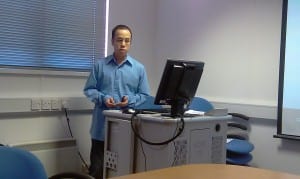 A new book, Ambulance Services: Leadership and Management Perspectives by Professors Paresh Wankhade and Kevin Mackway-Jones, features a chapter on equality and diversity in prehospital care, co-authored by Viet-Hai Phung and Prof Niro Siriwardena of CaHRU together with Dr Karen Windle of the School of Health and Social Care. The new volume also refers to CaHRU’s work in developing indicators and processes for measuring and improving the quality of care provided by ambulance services.
A new book, Ambulance Services: Leadership and Management Perspectives by Professors Paresh Wankhade and Kevin Mackway-Jones, features a chapter on equality and diversity in prehospital care, co-authored by Viet-Hai Phung and Prof Niro Siriwardena of CaHRU together with Dr Karen Windle of the School of Health and Social Care. The new volume also refers to CaHRU’s work in developing indicators and processes for measuring and improving the quality of care provided by ambulance services.
 The chapter, Responding to diversity and delivering equality in prehospital care: statutory responsibilities, best practice and recommendations, explores the impact of increasing diversity in the UK population and NHS workforce on prehospital care delivery. As public sector organisations, ambulance services are bound by The Equality Act 2010, which obliges them to promote equality and outlaw discrimination, harassment and victimisation of people with protected characteristics such as age, disability, race, gender and sexual orientation. Ambulance services use the Equality Delivery System (EDS), a voluntary toolkit that provides guidance about how they can achieve their duties set out in The Equality Act 2010. Building on the original EDS, the new EDS2 framework encourages organisations to flexibly reflect local sensitivities.
The chapter, Responding to diversity and delivering equality in prehospital care: statutory responsibilities, best practice and recommendations, explores the impact of increasing diversity in the UK population and NHS workforce on prehospital care delivery. As public sector organisations, ambulance services are bound by The Equality Act 2010, which obliges them to promote equality and outlaw discrimination, harassment and victimisation of people with protected characteristics such as age, disability, race, gender and sexual orientation. Ambulance services use the Equality Delivery System (EDS), a voluntary toolkit that provides guidance about how they can achieve their duties set out in The Equality Act 2010. Building on the original EDS, the new EDS2 framework encourages organisations to flexibly reflect local sensitivities.
 There are still significant variations in the quality of data that ambulance services possess for different protected characteristic groups, which also makes progress towards greater equality difficult to measure. The chapter summarises the current policy, problems in delivering this and potential solutions to overcome these.
There are still significant variations in the quality of data that ambulance services possess for different protected characteristic groups, which also makes progress towards greater equality difficult to measure. The chapter summarises the current policy, problems in delivering this and potential solutions to overcome these.
Viet-Hai Phung


![image.jpeg_(1)[1]](https://communityandhealth.dev.lincoln.ac.uk/files/2014/10/image.jpeg_11-90x150.jpg)